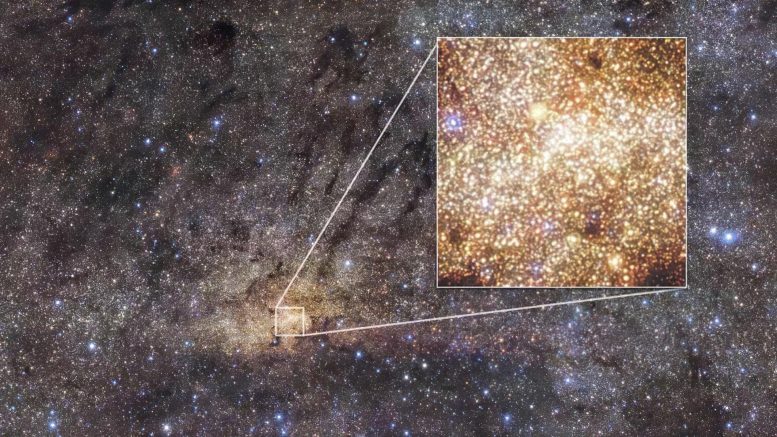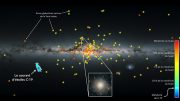
The image, taken with ESO’s Very Large Telescope in Chile, shows a high-resolution view of the innermost parts of the Milky Way. In the new study, the researchers examined the dense nuclear star cluster shown in detail here. Credit: ESO
Through the study of detailed data obtained from a powerful ten-meter telescope located in Hawaii, a team of scientists at Lund University in Sweden have made significant discoveries regarding three stars situated in the central region of the Milky Way galaxy. These stars were found to be unusually young with a puzzling chemical composition that surprised the researchers.
The study, which has been published in The Astrophysical Journal Letters, examined a group of stars located in the nuclear star cluster that makes up the heart of the galaxy. It concerns three stars that are difficult to study because they are extremely far away from our solar system, and hidden behind enormous clouds of dust and gas that block out light. The fact that the area is also full of stars makes it very complicated to discern individual stars.
In a previous study, the researchers put forward a hypothesis that these specific stars in the middle of the Milky Way could be unusually young.
Verification of Young Stars in the Galaxy’s Core
“We can now confirm this. In our study, we have been able to date three of these stars as relatively young, at least as far as astronomers are concerned, with ages of 100 million to about 1 billion years. This can be compared with the sun, which is 4.6 billion years old,” says Rebecca Forsberg, a researcher in astronomy at Lund University.
The nuclear star cluster has mainly been seen, quite rightly, as a very ancient part of the galaxy. But the researchers’ new discovery of such young stars indicates that there is also active star formation going on in this ancient component of the Milky Way. However, dating stars 25,000 light years from Earth is not something that can be done in a hurry.
The researchers used high-resolution data from the Keck II telescope in Hawaii, one of the world’s largest telescopes with a mirror ten meters in diameter. For further verification, they then measured how much of the heavy element, iron, the stars contained. The element is important for tracing the galaxy’s development, as the theories the astronomers have about how stars are formed and galaxies develop indicate that young stars have more of the heavy elements, as heavy elements are formed to an increasing extent over time in the universe.
To determine the level of iron, the astronomers observed the stars’ spectra in infrared light which, compared with optical light, are parts of the light spectrum that can more easily shine through the densely dust-laden parts of the Milky Way. It was shown that the iron levels varied considerably, which surprised the researchers.
Implications for Understanding the Galaxy and the Universe
“The very wide spread of iron levels could indicate that the innermost parts of the galaxy are incredibly inhomogeneous, i.e. unmixed. This is something we had not expected and not only says something about how the center of the galaxy appears, but also how the early universe may have looked,” says Brian Thorsbro, a researcher in astronomy at Lund University.
The study sheds significant light on our understanding of the early universe and the functioning of the very center of the Milky Way. The results may also be of benefit to inspire continued and future explorations of the heart of the galaxy, as well as the further development of models and simulations of the formation of galaxies and stars.
“Personally, I think it is very exciting that we can now study the very center of our galaxy with such a high level of detail. These types of measurements have been standard for observations of the galactic disc where we are located, but have been unreachable goals for more faraway and exotic parts of the galaxy. We can learn a lot about how our home galaxy was formed and developed from such studies,” concludes Rebecca Forsberg.
Reference: “A Wide Metallicity Range for Gyr-old Stars in the Nuclear Star Cluster” by B. Thorsbro, R. Forsberg, G. Kordopatis, A. Mastrobuono-Battisti, R. P. Church, R. M. Rich, N. Ryde, M. Schultheis and S. Nishiyama, 21 November 2023, The Astrophysical Journal Letters.
DOI: 10.3847/2041-8213/ad08b1
In addition to Lund University, the following organizations and higher education institutions participated in the study: Observatoire de la Côte d’Azur, the University of Tokyo, Observatoire de Paris, the University of California Los Angeles, and Miyagi University of Education.









Be the first to comment on "Puzzling Baby Stars at the Galaxy’s Core: Astronomers Unravel Age Mystery"